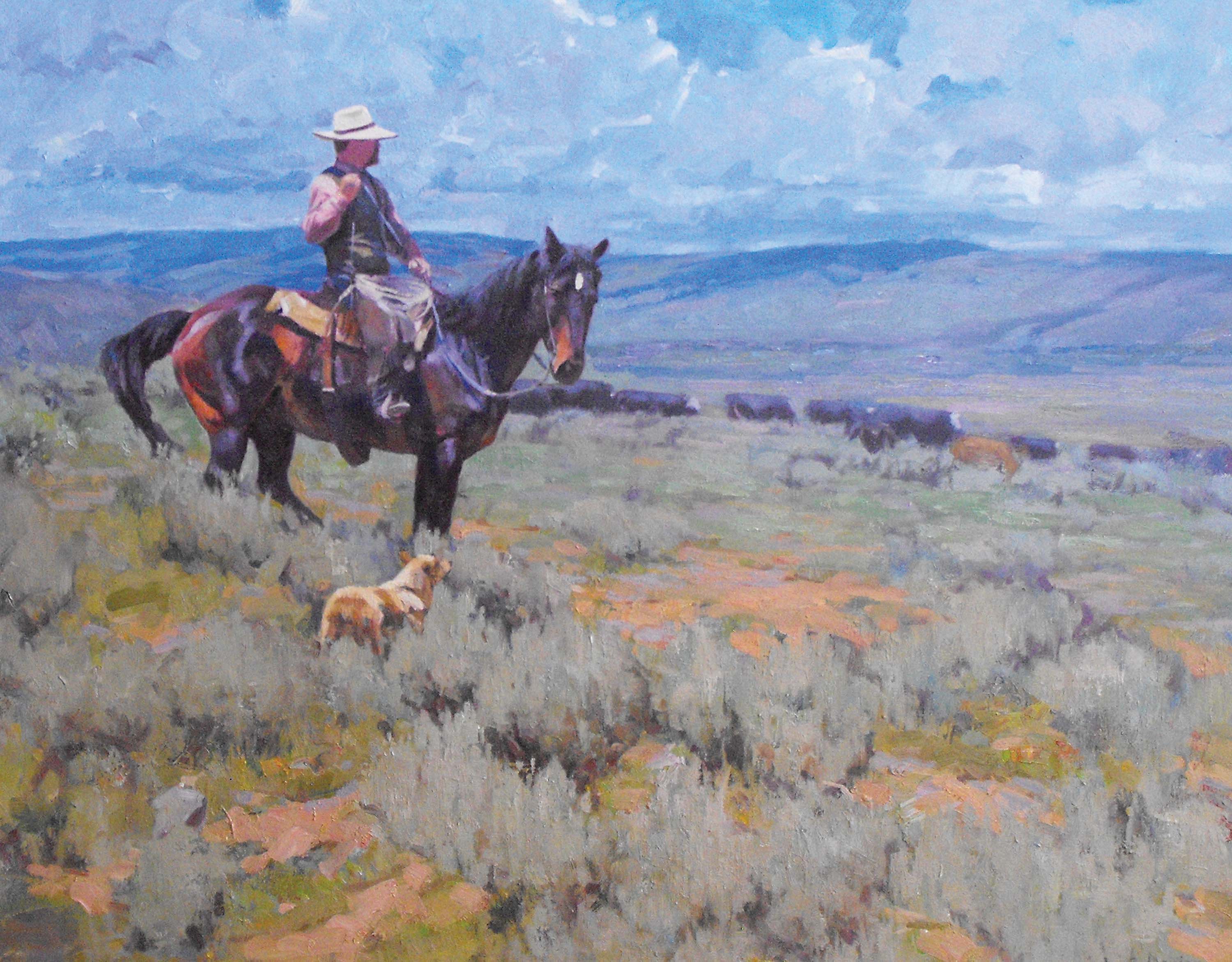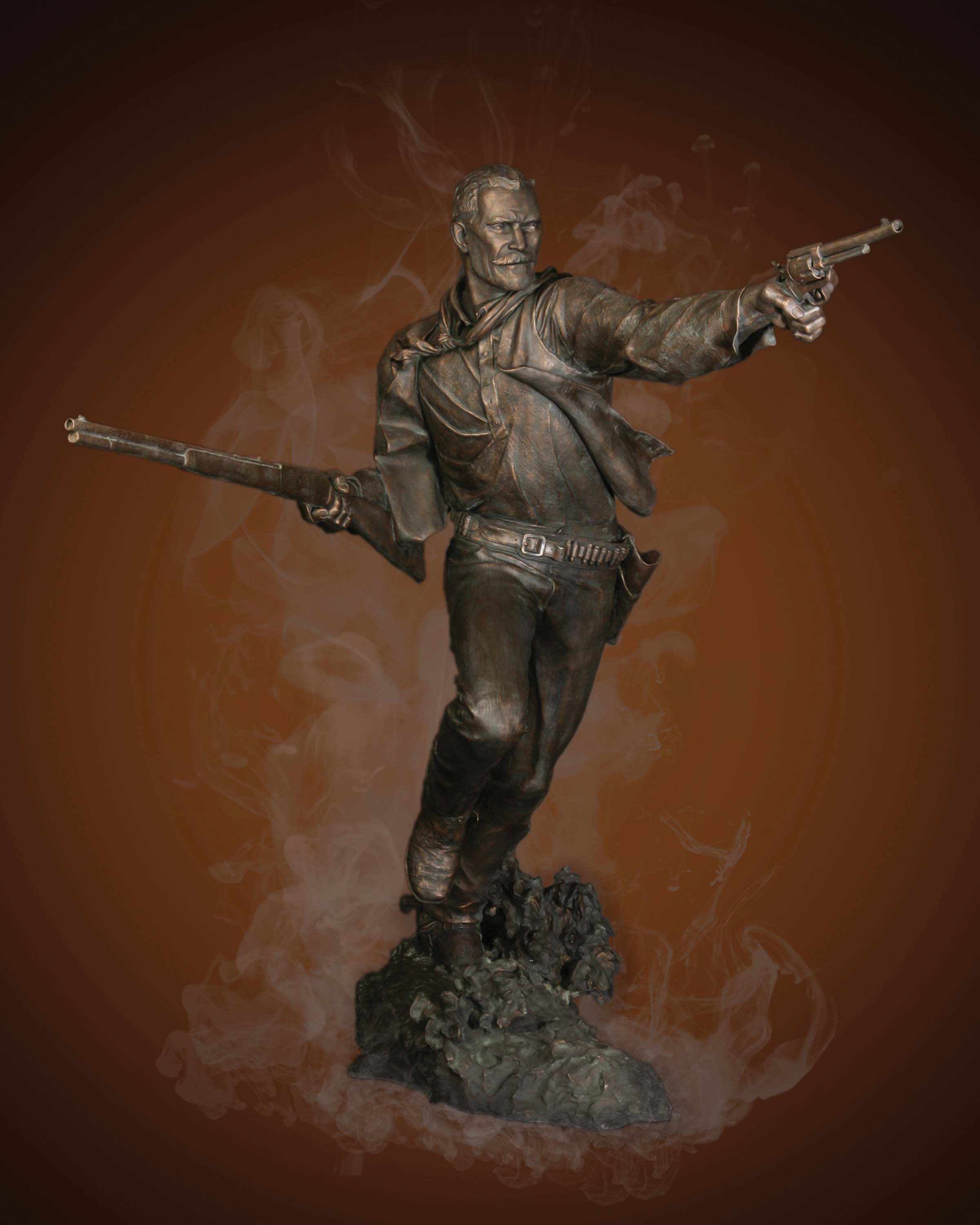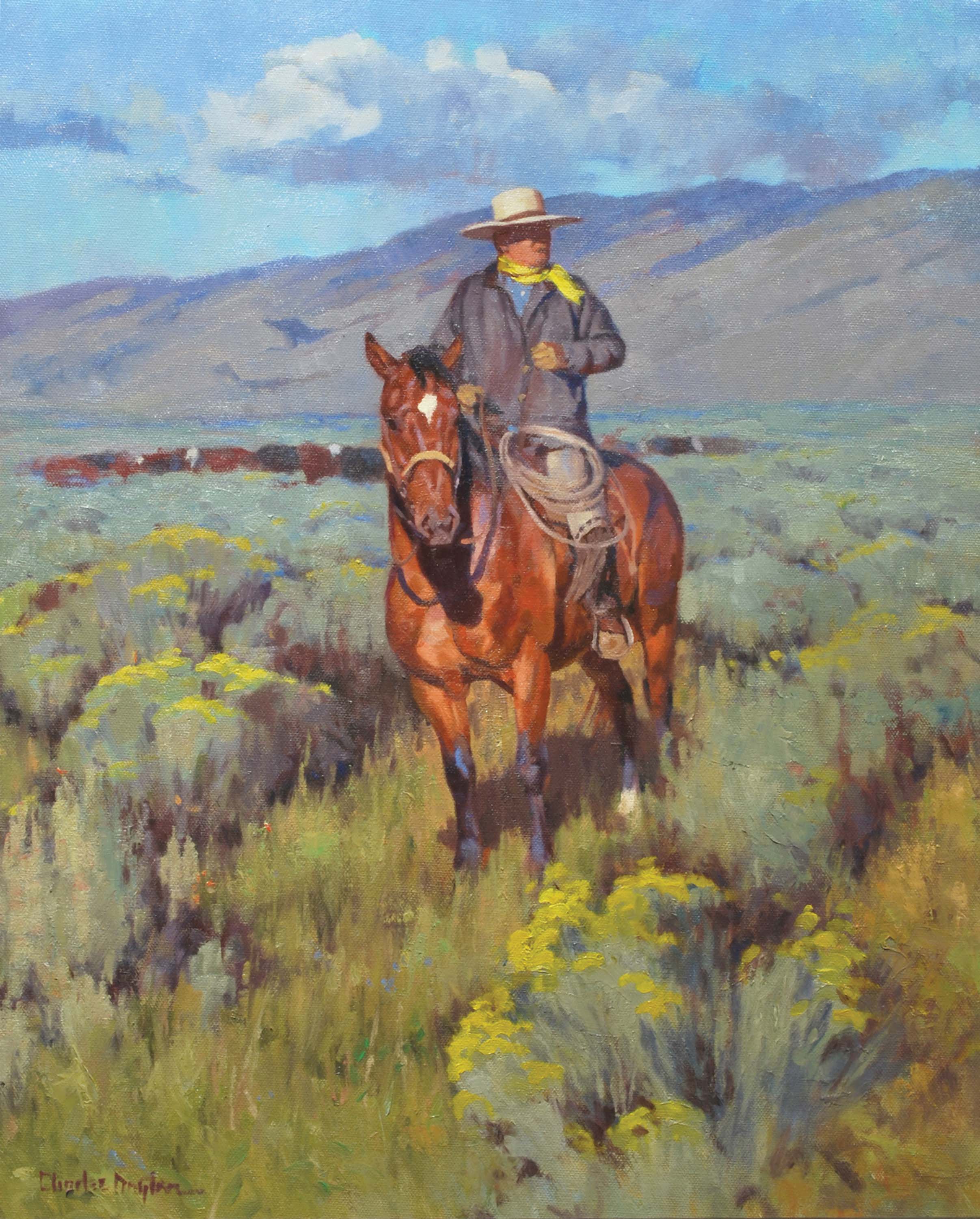
19 Oct A Life they Know
MICHAEL THOMAS CAN STILL REMEMBER THE FIERCE WIND, stinging snow and biting cold of a late fall storm that swept across the rangelands of Wyoming where he and his father were on horseback, driving cattle.
Thomas was just a boy when nature unleashed itself and subjected father and son to merciless cold.
“I thought I was in trouble,” Thomas recalled. “Then I became aware of my dad coming up and saying, ‘Get off your horse.’ He sat me down, covered me with his arms and his jacket and, after a time, I warmed up.”
A moment that seemed to stretch for an eternity was captured in bronze by Thomas decades later. Cryin’ Cold, a tabletop sculpture depicting a seated man enveloping a boy as an unseen wind whips the tails of their horses, is Thomas’s artistic testimony to a real-life experience on the range.
In the tradition of wrangler-turned-Western-art-icon Charles M. Russell, Thomas is an artist whose work is informed by the cowboy way because he has lived it. He is among select artists, including painter Charles Dayton and custom saddlemaker Cary Schwarz, whose pieces exhibit an authenticity earned by working cattle in scenic but challenging landscapes where nature is fate, friend and foe.
The appeal is ageless in a nation that celebrates the cowboy, a figure that emerged amid 19th-century Western expansionism and rapidly gained folk-hero status. The rugged individualist willing to vie with the untamed West as presented in images and in popular writings of the day was in stark contrast to the model of masculinity embodied by the Eastern industrialist.
“The Progressive Era brings a relocation of American masculinity from the industrialized East to the Western frontier. The cowboy comes to represent that shift and is the ultimate protagonist in an evolving story about national identity,” said Amy Scott, the Marilyn B. and Calvin B. Gross curator of visual arts with the Autry National Center.
In an ode to Russell, Thomas shapes sculptures in his studio in north central Wyoming that immortalize the characters and cultures that colored the Old West.
There is Nate Champion’s Last Run, the nearly life-size bronze of a Wyoming rancher who gained a larger-than-life reputation in 1892 for singlehandedly holding at bay hired guns sent by outside cattle barons to kill him for disputing round-up practices on the range that benefited them at the expense of small, independent ranchers such as Champion.
Thomas depicts Champion after his cabin was set aflame. The lone Westerner, guns blazing, is without fear in the face of certain death. “He was a tough hombre,” Thomas says of a man who homesteaded — and lost his life — in an early battle over rights on the range that happened in the shadow of the Big Horn Mountains, not far from rural Buffalo, Wyoming, where Thomas now lives.
Thomas seeks out the untold stories of the West tied to individuals whose fortitude and triumphs might otherwise be lost to posterity. In the decades since he first turned his ranching experience, his bachelor’s in animal science and his gift for perceiving in three dimensions to the pursuit of art, he has been commissioned by the University of Wyoming to produce two monumental bronzes commemorating the links between his alma mater and Wyoming to the cowboy and the cowgirl.
Bill King, owner of Bozeman Trail Gallery in Sheridan, Wyoming, said all of his major clients have a Thomas bronze in their collections.
“The history, the native culture and the cowboy lifestyle are wrapped into his work. He’s lived that life; there is no imitation,” said King.
Likewise, there is little make believe in Charles Dayton’s paintings of ranchers tending cattle in Bear River country in southwest Wyoming. Midsummer herding, shifts of light and lone figures on horseback are the hallmarks of a tradition that Dayton claimed in his youth on the family ranch and which he has reclaimed for his children. When Dayton chose art over a successful career in business consulting in Utah, he returned to the sage and grasslands his ancestors settled at the turn of the 20th century.
There are no streamside cottonwoods, no pine stands in the high country and no clumps of rabbit brush across a vast, mostly unmarked landscape, that have gone unnoticed by Dayton. But it is the mystique of a solitary man amid the elements and domestic animals that Dayton captures in oil; and it is a scene that recurs, effortlessly and eternally, as seasons, centuries and generations pass.
If Frederic Remington was a father of Western art, then Dayton is an heir. Yet, unlike Remington, Dayton is representing an American West that is not in conflict. In open spaces where cultures warred men died and pastoral prospects dimmed, Dayton has rubbed out violence and sketched in harmony.
Dayton gains inspiration for his mounted figures from real-life. The cowboy in The Yellow Scarf is based on a cousin, whoalso was the model for the rider in Partners on the Drive. Yet the figures that appear born to the saddle and so at one with the rugged terrain maintain a degree of mystery, their faces in profile and their features obscured by wide-brimmed hats.
Dayton is attentive to detail without being dominated by it. His paintings adeptly portray the Wyoming sky of many colors and a loosely rendered range where grasses and brush add depth.
Curtis Tierney, owner of Tierney Fine Art in Bozeman, Montana, grew up on a fourth-generation ranch and can say with authority that Dayton delivers authenticity even as he conveys the ethos of ranching.
“It can be something as subtle as the posturing and conformation of a horse, the change in direction of reins or the twist of the cowboy’s neck as he looks back to check cattle,” said Tierney.
Authenticity is the byword at the studio near the mountain town of Salmon in east central Idaho where Cary Schwarz builds custom saddles. A skilled horse- man who can ride the range, trail cows and fix fences like a lifetime rancher, Schwarz produces saddles that strike the balance between form and function, art and craft.
Schwarz’s talent for design, innate artistry and a mastery of leather are stamped on each museum-quality piece he creates for collectors and every working saddle he crafts for cowboys.
A founding member of the Traditional Cowboy Arts Association, which seeks to preserve and promote crafts tied to the cowboy culture, Schwarz compares the lines of a saddle to the lines of a building in which each element must complement the whole while adhering to architectural and structural engineering principles.
“A building may be beautiful but it also must be functional: the roof can’t fall in, it has to work. That is also true for saddles,” he said.
Recognized in 2010 for excellence in folk and traditional arts as part of the Idaho Governor’s Awards in the Arts program, Schwarz strives to impart through his work what he calls the cowboy ethic of faith, hard work and connection to the land. Each flower Schwarz carves, each vine he tools, each stitch he sinks into leather is a visual testament to a Western legacy that he feels honor-bound to uphold.
Schwarz strives to equal the standard in saddlemaking established in the late 1800s by a company in California. Those saddles stood out for decoration that was more realistic and less stylized, unusual for both the period and the region.
In a career spanning three decades, Schwarz has sought to minimize the tensions between function and art in his saddles.
“To me, it’s seamless: so many aspects of artistry dove-tail with function,” he said.
Don Reeves, McCasland chair of cowboy culture for the National Cowboy & Western Heritage Museum, said Schwarz’s rural Idaho upbringing and his ties to working ranches form the basis of a talent that is inseparable from the environment.
“Cowboy artists are shaped by knowledge of the land, knowledge of the life,” he said. “These are artists who innately understand what they are seeing and try to interpret that in their work.”
Authenticity is the byword at the studio near the mountain town of Salmon in east central Idaho where Cary Schwarz builds custom saddles. A skilled horse- man who can ride the range, trail cows and fix fences like a lifetime rancher, Schwarz produces saddles that strike the balance between form and function, art and craft.
Schwarz’s talent for design, innate artistry and a mastery of leather are stamped on each museum-quality piece he creates for collectors and every working saddle he crafts for cowboys.
A founding member of the Traditional Cowboy Arts Association, which seeks to preserve and promote crafts tied to the cowboy culture, Schwarz compares the lines of a saddle to the lines of a building in which each element must complement the whole while adhering to architectural and structural engineering principles.
“A building may be beautiful but it also must be functional: the roof can’t fall in, it has to work. That is also true for saddles,” he said.
Recognized in 2010 for excellence in folk and traditional arts as part of the Idaho Governor’s Awards in the Arts program, Schwarz strives to impart through his work what he calls the cowboy ethic of faith, hard work and connection to the land. Each flower Schwarz carves, each vine he tools, each stitch he sinks into leather is a visual testament to a Western legacy that he feels honor-bound to uphold.
Schwarz strives to equal the standard in saddlemaking established in the late 1800s by a company in California. Those saddles stood out for decoration that was more realistic and less stylized, unusual for both the period and the region.
In a career spanning three decades, Schwarz has sought to minimize the tensions between function and art in his saddles.
“To me, it’s seamless: so many aspects of artistry dove-tail with function,” he said.
Don Reeves, McCasland chair of cowboy culture for the National Cowboy & Western Heritage Museum, said Schwarz’s rural Idaho upbringing and his ties to working ranches form the basis of a talent that is inseparable from the environment.
“Cowboy artists are shaped by knowledge of the land, knowledge of the life,” he said. “These are artists who innately understand what they are seeing and try to interpret that in their work.”
- D. Michael Thomas | “Cryin’ Cold” | Bronze | 3 x 17 x 10 inches
- Charles Dayton, “Partners on the Drive” | Oil on Board | 18 x 24 inches | 2013
- Saddlemaker Cary Schwarz poses alongside one of his own saddles.
- D. Michael Thomas | “Nate Champion’s Last Run” | Bronze | 7 feet x 6 inches
- Charles Dayton, “The Yellow Scarf” | Oil on Canvas | 16 x 20 inches | 2013 
- Schwarz’s intricate detailing is visible even on the inside of the leather and silver stirrup.
- Schwarz often includes ornate and traditional flowers in his work, as is evident both in the carved leather and the filigreed silver horn which was designed, fabricated and engraved by Scott Hardy.
- This “mochilla” style saddle is reminiscent of the 19th century but serviceable for today’s use. The saddle, both “tough and tender,” as the artist describes it, reflects the way the West was established thanks to a combination of rugged individuals and compassionate communities. It will appear in Cowboy Crossings this November at the National Cowboy Museum in Oklahoma City.
















No Comments